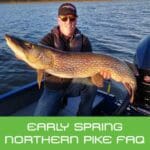Order by 3 PM CT for Same-Day Free Shipping (Lower 48 | Mon-Fri)
Experienced Northern Pike angler Mark Harder, based in Canada, has put together this great list of 10 FAQ around targeting early spring northern pike. Mark is just as passionate about catching pike as he is sharing these tips with others to help get them to get into some great fishing.
Whilst Mark’s experience is based in Canadian waters these 10 tips for Northern Pike will be relevant in other parts of the Northern Hemisphere where pike are a target species, like Ireland, Germany and more…
Early Spring Northern Pike FAQ:
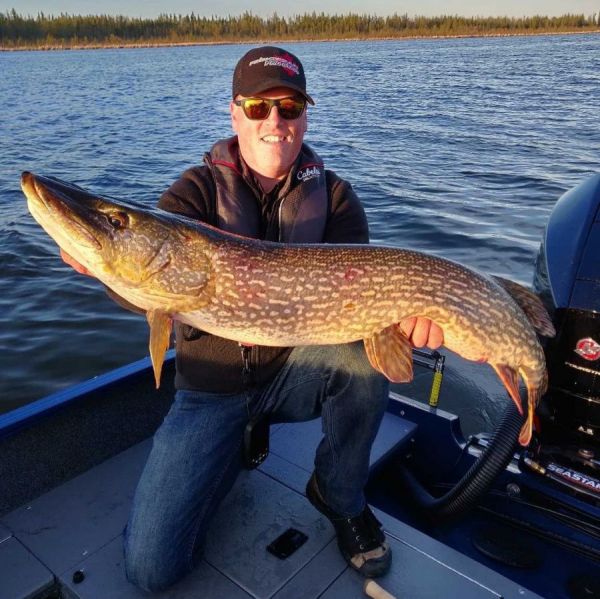
The old adage “past performance determines future success” is quite often true when it comes to selecting the bodies of water that hold large northern pike. Some lakes just have all the ingredients needed to grow big fish; an abundance of forage, low fishing pressure, tight fishing regulations, good weed cover, and sufficient depths all contribute to the ability of a body of water to grow large pike.
That isn’t to say that you need to travel to the ends of the earth to find large northern pike. Some of the biggest pike I have caught have been in bodies of water that are close to large communities but they are overlooked in favor of a different lake that surely has bigger fish because it is farther away. This is sort of like “the best fishing is on the far side of the lake” no matter what side of the lake you started from!
I use satellite imagery to identify suitable back bays where there is an inflow of water, shallow depth (2-6 feet), and ideally full sun exposure. Inflows carry sediment into the lake and over many years they create fertile shallow flats that contain a lot of vegetation. These shallow areas warm faster than other areas of the lake which in turn causes the vegetation to regrow faster than in the other areas of the lake. This combination of warm water and vegetation attracts spawning northern pike who lay their eggs on the vegetation where it sticks, keeping it oxygenated and above the silty bottom. Baitfish also tend to move into these areas, using vegetation for cover and gorging on the aquatic life that is most active in these warmest areas of the lake.
Once I have identified the bay I want to fish, I tend to start in the shallows that are south facing as they warm up first and therefore have the greatest plant growth and aquatic life. If I am not finding the big pike in shallow I will begin to work into cooler waters, either shaded or deeper.
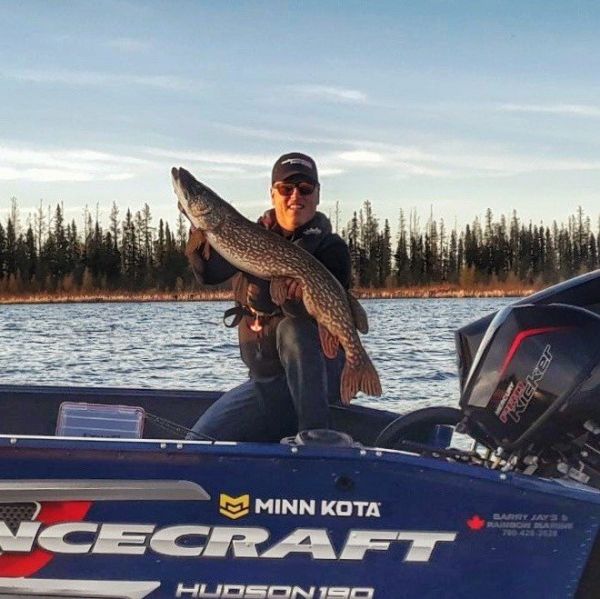
Most definitely. While not all bodies of water will contain large northern pike, the largest pike in the lake will easily be found in early spring by finding the areas outlined above. Once you have located these areas it is all about timing. If you are too early the water will be too cool and the pike will be in pre-spawn, if you are too late the water has warmed in the rest of the lake allowing the pike to move to deeper water where they are less concentrated.
We all know that sound travels very well in water, so a stealthy approach in these shallow areas is critical. My preference is to slowly drift through these shallows, making long casts as I go to ensure that I cover as much area as possible. If I have two people in the boat I will have the one in the bow cast into the shallows ahead of the boat and the one in the rear cast towards the deeper areas. The idea behind this is that the pike will likely move deeper once they become aware of the boat presence, allowing the fisher in the rear of the boat to have another chance at them.
Once I reach the end of my drift, I will use a bow mounted electric motor to slowly work my way back into the wind, continuing to cast as before. If I find a spot that is productive I will anchor there and methodically work the area with casts. As much as I love my GPS anchor mode on my electric trolling motor, I avoid using it in these shallow areas as it continually stirs up the bottom making visibility an issue as well as noise.
My personal favourites are large paddle tail softbaits such as the Rapala Peto (burbot pattern), the Storm Wildeye (4” length in either perch or walleye pattern) and the Storm 360GT (5 ½” length in Houdini color) for pike. The running depth of these baits is controlled by the rate of retrieve. I like to reel them as slowly as possible while still running above the tops of the weeds. A slow, steady retrieve is often the best as this time of year pike like to follow the baits before they commit. I find that most big pike strike right beside the boat, so be sure to pause before you lift the bait out of the water. I always make my lure barbless, allowing for easier hook removal.
Surface baits like poppers are also a lot of fun this time of year. I find that they catch smaller fish than the big swimbaits, but the surface strikes provide a lot of excitement!
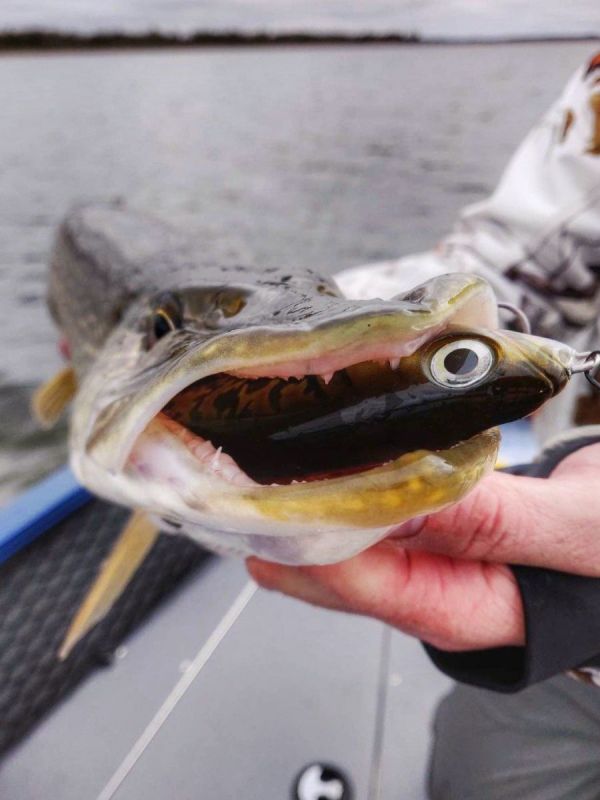
I primarily use casting reels for large pike. Their smooth drag systems and cranking power are ideal for powerful fish like a large northern pike. The two reels that I use primarily are the Shimano Tranx 301HG and the Shimano Curado K 201XG. I pair these with either a Shimano Zodias MH or G Loomis E6X MH rod in a minimum length of 7 feet.
I use either PowerPro SuperSlick V2 braid in 50# rating or PowerPro Maxcuatro braid in 65# as my mainline. I then use either an FG knot or an Alberto knot to tie on Seaguar Blue Label Flourocarbon in 30# rating. Finally, I tie on an 8” premade titanium leader to prevent bite offs. While wire leaders will work, they tend to become a twisted-up mess after the first fish, affecting the lure action. Titanium leaders are pricey, but they will last you much longer than a wire leader.
Sonar technology is a huge help with all aspects of fishing. I use the Humminbird Autochart system to create accurate depth maps of the lakes that I fish. These maps help me to identify not only key depth structures, but also weedlines, and changes in bottom composition. My Princecraft Xpedition 200 has a rail mounting system that works well with the Railblaza Tracloader Sideport. I mount my Humminbird Helix units on a Railblaza Rotating Platform R and use the Sideport to locate it where I need it. This versatility allows me to see and control my sonar from any position in my boat, which is a great advantage.
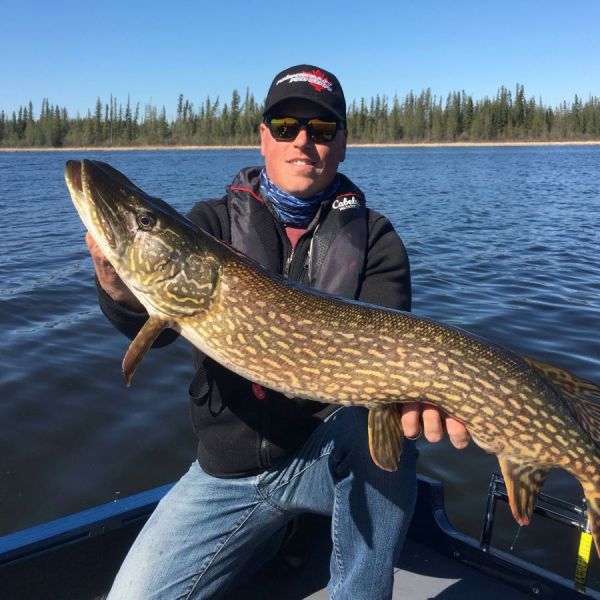
A fish cradle or large net with a rubber-coated basket is ideal for large pike. These fish tend to roll in a conventional net which causes damage to their skin, tangles the lure in the net, and generally makes releasing more difficult. A proper cradle helps to keep them horizontal, calm, and controlled.
Once you have the pike in the net, gather the tools you need to remove the hook. If it is not hooked deeply you will likely only need pliers to pop the hook out. If the lure has been taken deeply you will likely need a mouth spreader to open the pike’s mouth, allowing you to remove the hook without causing damage. This is where barbless hooks are helpful. It is also helpful to have a pair of side cutters handy, allowing you to cut a hook if it is deeply caught. I try to do all of this while the fish remains in the water to minimize handling.
Large pike are usually females and are key to ensuring healthy populations of pike in the lake. Many of these large pike are caught in cold northern waters where growth rates are slow, so releasing them will help ensure that there is a viable population of large pike for future fishing trips and fishermen. Treat them with respect and return to catch them another day.
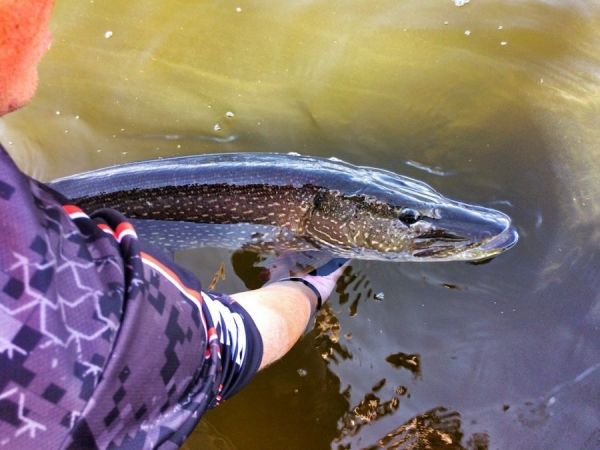
About Mark Marder Harder Outdoors
I fish a number of waterbodies across the Canadian provinces of Alberta and Saskatchewan, primarily focusing on northern pike (Esox Lucius) and walleye (Sander Vitreus) in northern lakes. My goal in fishing is to bring new people into the sport, teaching them techniques, equipment, handling, and the fun that comes with being out on the water.
One of my most enjoyed fishing styles is pursuing large northern pike in early spring. Not only are they usually the easiest to locate at “ice out”, they willing participants and are a great test of your equipment.
